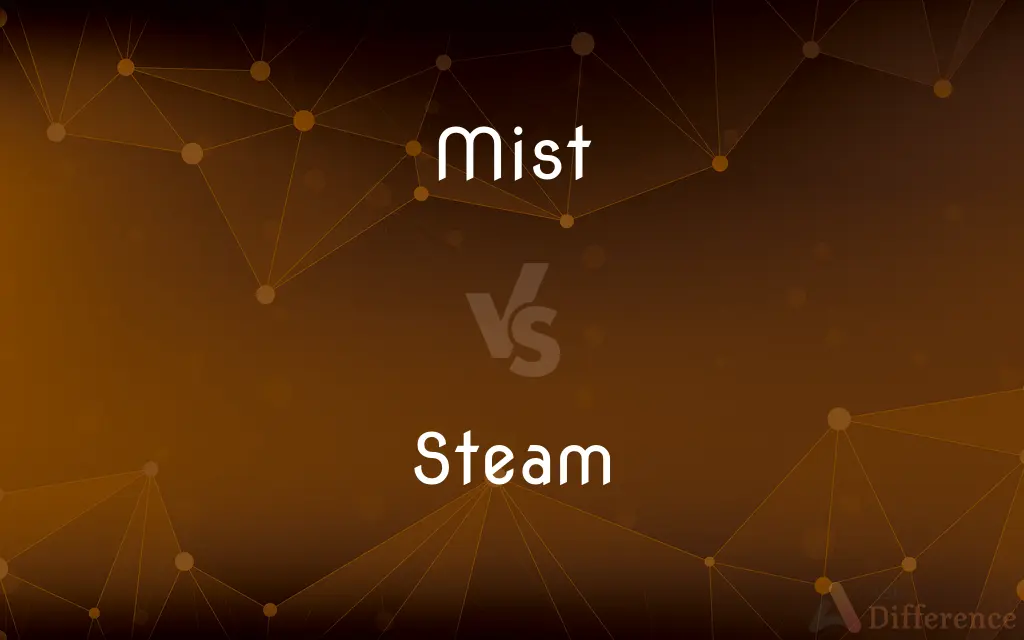Mist vs. Steam — What's the Difference?
By Urooj Arif & Fiza Rafique — Updated on April 15, 2024
Mist consists of tiny water droplets suspended in air, often seen in natural settings, while steam is water vapor, invisible and hotter, released during boiling.

Difference Between Mist and Steam
Table of Contents
ADVERTISEMENT
Key Differences
Mist forms when water droplets are suspended in the air, typically at lower altitudes and in cooler conditions, resulting in a thin, visible haze. On the other hand, steam occurs when water is heated to its boiling point and transitions into a gas, becoming invisible unless it begins to condense into water droplets upon cooling in the air.
Mist is visible and appears as a fine spray or light fog, commonly occurring in natural environments like valleys and mountains, especially during the early morning or after rainfall. Whereas steam is initially invisible because it is composed of water vapor, it only becomes visible when it cools and condenses into tiny droplets, similar to mist, often seen around boiling kettles or steam engines.
The temperature at which mist forms is typically close to the ambient air temperature, caused by slight cooling that allows air to reach its dew point. In contrast, steam is produced at a much higher temperature, specifically at the boiling point of water (100°C or 212°F at sea level), which significantly differentiates it in terms of energy content and temperature.
While mist generally cools the surrounding environment due to the latent heat of evaporation being absorbed from the air, steam, on the other hand, releases heat into the surrounding environment as it condenses, often feeling hot to the touch if encountered directly.
In terms of duration and persistence, mist can linger for hours, particularly in stable atmospheric conditions, whereas steam disperses quickly once removed from its heat source, reflecting its dependence on continual high-energy conditions for formation.
ADVERTISEMENT
Comparison Chart
Composition
Tiny water droplets
Water vapor (gas)
Visibility
Visible as a fine spray
Invisible when hot, visible when condenses
Temperature
Forms at near ambient temperature
Forms at or above 100°C (boiling point of water)
Common Occurrence
Natural settings, cool climates
Industrial settings, cooking, heating
Duration
Can linger for hours
Disperses quickly without heat source
Compare with Definitions
Mist
Used metaphorically to describe a vague or indistinct quality.
The mist of uncertainty that had clouded his decision cleared away.
Steam
A cleansing and cooking medium known for its heat.
She used steam to clean the grimy surfaces effectively.
Mist
A product of fine spray mechanisms, used in various applications.
The greenhouse uses a mist system to hydrate plants efficiently.
Steam
Used in power generation, cooking, and heating processes.
The old factory operated a large steam-powered generator.
Mist
Water droplets suspended in the air, creating a light haze.
The valley was covered in a soft mist early in the morning.
Steam
Water vapor that is invisible when hot, visible when cooling.
Steam rose swiftly from the boiling pot of water.
Mist
A phenomenon causing reduced visibility, but not as dense as fog.
A gentle mist settled over the town, blanketing the streets.
Steam
Often associated with high temperatures and pressure systems.
Careful when opening the pressure cooker to avoid the steam.
Mist
Refers to something that obscures or blurs.
Her glasses fogged up with a mist from the hot tea.
Steam
Metaphorically, to express energy or anger.
He let off steam after the stressful meeting with a long run.
Mist
Mist is a phenomenon caused by small droplets of water suspended in air. Physically, it is an example of a dispersion.
Steam
Steam is water in the gas phase. This may occur due to evaporation or due to boiling, where heat is applied until water reaches the enthalpy of vaporization.
Mist
A cloud of tiny water droplets suspended in the atmosphere at or near the earth's surface that limits visibility (to a lesser extent than fog; strictly, with visibility remaining above 1 km)
The peaks were shrouded in mist
A mist rose out of the river
Steam
The vapour into which water is converted when heated, forming a white mist of minute water droplets in the air
A cloud of steam
She wiped the steam off the mirror
Steam was rising from the mugs of coffee
Mist
Cover or become covered with mist
The windows of the car were misted up with condensation
The glass was beginning to mist up
Steam
Give off or produce steam
A mug of coffee was steaming at her elbow
Mist
A mass of fine droplets of water in the atmosphere near or in contact with the earth.
Steam
Cook (food) by heating it in steam from boiling water
Steam the vegetables until just tender
Mist
Water vapor condensed on and clouding the appearance of a surface.
Steam
(of a ship or train) travel somewhere under steam power
The 11.54 steamed into the station
Mist
Fine drops of a liquid, such as water, perfume, or medication, sprayed into the air.
Steam
Be or become extremely agitated or angry
You got all steamed up over nothing!
After steaming behind the closed door in his office, he came out and screamed at her
Mist
A suspension of fine drops of a liquid in a gas.
Steam
Hot water vapor produced especially by boiling liquid water.
Mist
Something that dims or conceals.
Steam
Hot, pressurized water vapor used for heating, cooking, or to provide mechanical power.
Mist
A haze before the eyes that blurs the vision.
Steam
Power generated by the expansion of boiling water as it turns to vapor
An engine at full steam.
Mist
Something that produces or gives the impression of dimness or obscurity
The mists of the past.
Steam
Steam heating.
Mist
A drink consisting of a liquor served over cracked ice.
Steam
Condensed water vapor in the form of a mist or cloud
The steam from the teakettle.
The steam of the oxen's breath in the cold air.
Mist
To be or become obscured or blurred by or as if by mist.
Steam
Power; energy
The fundraising effort ran out of steam.
Mist
To rain in a fine shower.
Steam
To produce or emit steam
The kettle is steaming. Let's make tea.
Mist
To conceal or veil with or as if with mist.
Steam
To become or rise up as steam
The rain steamed off the hot pavement.
Mist
To moisturize (plants or dry air, for example) with a fine spray of water.
Steam
To become misted or covered with steam
The bathroom mirror steamed over.
Mist
Water or other liquid finely suspended in air. fog, haze.}}
It was difficult to see through the morning mist.
Steam
To move by means of steam power.
Mist
(countable) A layer of fine droplets or particles.
There was an oily mist on the lens.
Steam
(Informal) To become very angry; fume.
Mist
(figurative) Anything that dims, darkens, or hinders vision.
Steam
To expose to steam, as in cooking.
Mist
To form mist.
It's misting this morning.
Steam
To cover or mist with steam
The windows are steamed up.
Mist
To spray fine droplets on, particularly of water.
I mist my tropical plants every morning.
Steam
(Informal) To make angry
His laziness really steams me.
Mist
To cover with a mist.
The lens was misted.
Steam
The vapor formed when water changes from the liquid phase to the gas phase.
Mist
(of the eyes) To be covered by tears.
My eyes misted when I remembered what had happened.
Steam
The suspended condensate (cloud) formed by water vapour when it encounters colder air
Mist
To disperse into a mist, accompanying operation of equipment at high speeds.
Steam
, fog
Mist
Visible watery vapor suspended in the atmosphere, at or near the surface of the earth; fog.
Steam
Exhaled breath into cold air below the dew point of the exhalation
Mist
Coarse, watery vapor, floating or falling in visible particles, approaching the form of rain; as, Scotch mist.
Steam
Pressurized water vapour used for heating, cooking, or to provide mechanical energy.
Mist
Hence, anything which dims or darkens, and obscures or intercepts vision.
His passion cast a mist before his sense.
Steam
The act of cooking by steaming.
Give the carrots a ten-minute steam.
Mist
To cloud; to cover with mist; to dim.
Steam
(figuratively) Internal energy for motive power.
After three weeks in bed he was finally able to sit up under his own steam.
Mist
To rain in very fine drops; as, it mists.
Steam
(figuratively) Pent-up anger.
Dad had to go outside to blow off some steam.
Mist
A thin fog with condensation near the ground
Steam
A steam-powered vehicle.
Mist
Become covered with mist;
The windshield misted over
Steam
Travel by means of a steam-powered vehicle.
Mist
Make less visible or unclear;
The stars are obscured by the clouds
Steam
(obsolete) Any exhalation.
Mist
Spray finely or cover with mist
Steam
(fencing) Fencing without the use of any electric equipment.
Steam
To cook with steam.
The best way to cook artichokes is to steam them.
Steam
(transitive) To expose to the action of steam; to apply steam to for softening, dressing, or preparing.
To steam wood or cloth
Steam
(intransitive) To produce or vent steam.
Steam
(intransitive) To rise in vapour; to issue, or pass off, as vapour.
Our breath steamed in the cold winter air.
Steam
To become angry; to fume; to be incensed.
Steam
To make angry.
It really steams me to see her treat him like that.
Steam
(intransitive) To be covered with condensed water vapor.
With all the heavy breathing going on the windows were quickly steamed in the car.
Steam
(intransitive) To travel by means of steam power.
We steamed around the Mediterranean.
The ship steamed out of the harbour.
Steam
To move with great or excessive purposefulness.
If he heard of anyone picking the fruit he would steam off and lecture them.
Steam
(obsolete) To exhale.
Steam
Old-fashioned; from before the digital age.
Steam
The elastic, aëriform fluid into which water is converted when heated to the boiling point; water in the state of vapor.
Steam
The mist formed by condensed vapor; visible vapor; - so called in popular usage.
Steam
Any exhalation.
Steam
To rise in vapor; to issue, or pass off, as vapor.
The dissolved amber . . . steamed away into the air.
Steam
To move or travel by the agency of steam.
The vessel steamed out of port.
Steam
To generate steam; as, the boiler steams well.
Steam
To exhale.
Steam
To expose to the action of steam; to apply steam to for softening, dressing, or preparing; as, to steam wood; to steamcloth; to steam food, etc.
Steam
Water at boiling temperature diffused in the atmosphere
Steam
Travel by means of steam power;
The ship steamed off into the Pacific
Steam
Emit steam;
The rain forest was literally steaming
Steam
Rise as vapor
Steam
Get very angry;
Her indifference to his amorous advances really steamed the young man
Steam
Clean by means of steaming;
Steam-clean the upholstered sofa
Steam
Cook something by letting steam pass over it;
Just steam the vegetables
Common Curiosities
Where is mist commonly found?
Mist is commonly found in natural settings, particularly in valleys, mountains, and during cooler weather conditions.
What is the primary difference between mist and steam?
Mist is made of water droplets in the air, visible and cool, while steam is hot water vapor, invisible until it cools and condenses.
Is steam always visible?
No, steam is invisible when it is in the form of hot water vapor; it only becomes visible when it cools and condenses into water droplets.
At what temperature does steam form?
Steam forms at the boiling point of water, which is 100°C (212°F) at sea level.
Can mist affect weather conditions?
Yes, mist can affect local weather conditions by cooling the air and slightly reducing visibility.
What uses does steam have?
Steam is used for various applications, including power generation, heating, and cooking.
Can steam be used for sterilization?
Yes, steam is often used for sterilization because its high heat can effectively kill bacteria and spores.
How is steam captured and utilized in industrial settings?
In industrial settings, steam is captured and utilized by containing it in boilers and steam engines where it can be directed to perform mechanical work.
What role does temperature play in the visibility of steam?
Temperature plays a crucial role; steam is invisible at higher temperatures but becomes visible as it cools and condenses into droplets.
Why is steam used in power generation?
Steam is used in power generation due to its ability to expand and exert pressure, which can be harnessed to move turbines.
How does mist form?
Mist forms when the air temperature cools to the dew point, causing water vapor to condense into tiny droplets near the ground.
Is mist dangerous to drive in?
Driving in mist can be hazardous as it reduces visibility; caution and reduced speeds are recommended.
How does the persistence of mist and steam differ?
Mist can linger for hours under stable conditions, while steam dissipates quickly once removed from the heat source.
What is the effect of steam on human skin?
Steam can cause burns if it contacts skin, due to its high temperature and heat transfer properties.
Does mist have any benefits to the environment?
Mist helps to maintain moisture levels in ecosystems, particularly in forested and mountainous areas, supporting local flora and fauna.
Share Your Discovery

Previous Comparison
Media vs. Medium
Next Comparison
Structuralism vs. FunctionalismAuthor Spotlight
Written by
Urooj ArifUrooj is a skilled content writer at Ask Difference, known for her exceptional ability to simplify complex topics into engaging and informative content. With a passion for research and a flair for clear, concise writing, she consistently delivers articles that resonate with our diverse audience.
Co-written by
Fiza RafiqueFiza Rafique is a skilled content writer at AskDifference.com, where she meticulously refines and enhances written pieces. Drawing from her vast editorial expertise, Fiza ensures clarity, accuracy, and precision in every article. Passionate about language, she continually seeks to elevate the quality of content for readers worldwide.














































